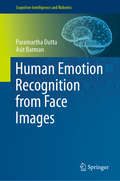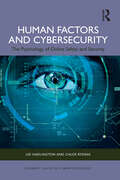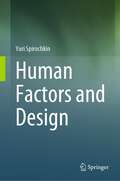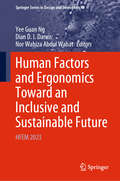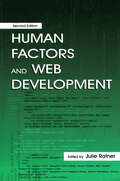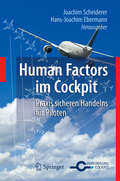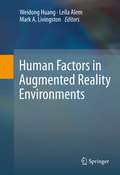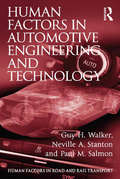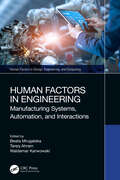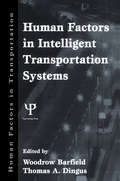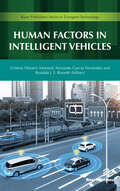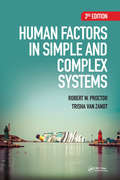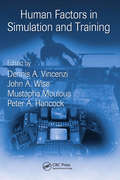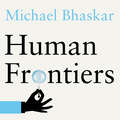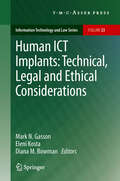- Table View
- List View
Human Emotion Recognition from Face Images (Cognitive Intelligence and Robotics)
by Paramartha Dutta Asit BarmanThis book discusses human emotion recognition from face images using different modalities, highlighting key topics in facial expression recognition, such as the grid formation, distance signature, shape signature, texture signature, feature selection, classifier design, and the combination of signatures to improve emotion recognition. The book explains how six basic human emotions can be recognized in various face images of the same person, as well as those available from benchmark face image databases like CK+, JAFFE, MMI, and MUG. The authors present the concept of signatures for different characteristics such as distance and shape texture, and describe the use of associated stability indices as features, supplementing the feature set with statistical parameters such as range, skewedness, kurtosis, and entropy. In addition, they demonstrate that experiments with such feature choices offer impressive results, and that performance can be further improved by combining the signatures rather than using them individually.There is an increasing demand for emotion recognition in diverse fields, including psychotherapy, biomedicine, and security in government, public and private agencies. This book offers a valuable resource for researchers working in these areas.
Human Entanglement Theory: A Quantum Approach to the Study of All-Encompassing Human Communication
by Christian AspalterThis innovative book has combined the latest drive to integrate the findings and principles of quantum mechanics and quantum technology, especially here quantum computing, into the flamboyant world of social sciences. Starting with Friedrich Nietzsche as a role model, especially his “Human, All-too-Human,” the book explores the world of interpersonal and intrapersonal, intercultural and transhistorical, human communication. This book uses an innovative experiential and abductive research design. The philosophy inspired by Nietzsche meets new inspirations stemming from quantum mechanics and quantum computing in particular. Building on derived guiding principles of (fuzzy) randomness, parallelity, and universality (with communication, words and feelings, as the least common denominator), the book arrives at the formation of a new quantum-inspired theory, called the Theory of Human Entanglement, where entanglements are causal forces for human communication (and hence human actions) that either instigate and propel, or inhibit and stifle human communication (and thus human actions). Human entanglements are diverse; they are complex and accumulative in nature. They operate in a multi-dimensional space, encompassing language usage (including their hidden connotations and culturally constructed truths, such as hidden notions of good and evil, allowed and forbidden), cultural traditions and limitations, governance, institutions, court rulings and practices, particular usages of common sense, local/neighborhood culture and practices, socio-economic and environmental forces and limitations, personal situations and experiences, personal thoughts, feelings, memories and aspirations, and much more. The theory may serve as starting point for greater causality focus in research design and applications across all social sciences and far beyond, especially when dealing with high number or infinite number of potentially causal and causal variables, as well as their aggregate forces (i.e. probability-based vector forces). On top, artificial intelligence applications, quantum information, and quantum finance applications, for example, may contribute to the further development of human entanglement theory, and vice versa.
Human Factor Security and Safety: A Behavioral Computing Approach
by Cheng WangAs we navigate an increasingly complex digital landscape, ensuring human factor security and safety has never been more critical. This groundbreaking book offers an innovative perspective by leveraging behavioral computing to address challenges in human factor security across diverse scenarios. Through comprehensive coverage, the book introduces advanced methods like behavioral modeling and simulation to analyze multimodal behavioral data—spanning structure, language, and vision. These approaches not only deepen our understanding of human behavior but also enable robust solutions to modern security concerns, presenting a new paradigm for safeguarding systems in dynamic environments. Ideal for researchers, professionals, and advanced students in security technologies and behavioral sciences, this work bridges theoretical frameworks with practical applications. Key topics include the evolution of behavioral paradigms, the role of behavioral structures in simulation, and real-world applications in cyberfinance and human factor engineering.
Human Factors Analysis of 23 Cyberattacks (The Human Element in Smart and Intelligent Systems)
by Abbas MoallemAs cyber threat actors have become more sophisticated, data breaches, phishing attacks, and ransomware are increasing, and the global cybercrime damage in 2021 was $16.4 billion a day. While technical issue analyses are fundamental in understanding how to improve system security, analyzing the roles of human agents is crucial. Human Factors Analysis of 23 Cyberattacks addresses, through examples, the human factors behind cybersecurity attacks.Focusing on human factors in individual attack cases, this book aims to understand the primary behaviors that might result in the success of attacks. Each chapter looks at a series of cases describing the nature of the attack through the reports and reviews of the experts, followed by the role and human factors analysis. It investigates where a human agent's intervention was a factor in starting, discovering, monitoring, or suffering from the attacks. Written in an easy-to-understand way and free from technical jargon, the reader will develop a thorough understanding of why cyberattacks occur and how they can be mitigated by comparison to the practical examples provided.This title will appeal to students and practitioners in the fields of ergonomics, human factors, cybersecurity, computer engineering, industrial engineering, and computer science.
Human Factors Engineering and Ergonomics: A Systems Approach
by Stephen J. GuastelloThis textbook comprehensively covers the basic principles and most recent advances regarding visual displays, auditory and tactile displays and controls; psychophysics; cognitive processes; human-computer interaction, artificial intelligence and artificial life; stress and human performance; occupational accidents and prevention; human group dynamics and complex systems; and anthropometry, workspace and environmental design. The systems perspective emphasizes nonlinear dynamics for system performance changes and emergent behaviours of complex person-machine systems.This book- • Surveys principles of conventional and computer-based machine interaction. • Assesses the relative effectiveness of accident analysis and prevention strategies. • Highlights nonlinear dynamics for system performance changes. • Examines artificial intelligence and complex systems. • Investigates sources of cognitive workload and fatigue. The textbook will be a valuable resource for advanced undergraduates and graduate students in diverse fields including ergonomics, human factors, cognitive science, computer science, operations management, and psychology. The textbook brings together core principles of person-machine interaction, accident analysis and prevention strategies, risk analysis and resilience, artificial intelligence, group dynamics, and nonlinear dynamics for an enhanced understanding of complex person-machine systems.
Human Factors Methods: A Practical Guide for Engineering and Design
by Daniel P. Jenkins Neville A. Stanton Guy H. Walker Paul M. Salmon Laura A. Rafferty Chris BaberThis second edition of Human Factors Methods: A Practical Guide for Engineering and Design now presents 107 design and evaluation methods as well as numerous refinements to those that featured in the original. The book has been carefully designed to act as an ergonomics methods manual, aiding both students and practitioners. The eleven sections represent the different categories of ergonomics methods and techniques that can be used in the evaluation and design process. Offering a 'how-to' text on a substantial range of ergonomics methods that can be used in the design and evaluation of products and systems, it is a comprehensive point of reference for all these methods. An overview of the methods is presented in chapter one, with a methods matrix showing which can be used in conjunction. The following chapters detail the methods showing how to apply them in practice. Flowcharts, procedures and examples cover the requirements of a diverse audience and varied applications of the methods. The final chapter, a new addition, illustrates the EAST method, which integrates several well-known methods into a teamwork analysis approach.
Human Factors and Cybersecurity: The Psychology of Online Safety and Security (Current Issues in Cyberpsychology)
by Lee Hadlington Chloe RydingHuman Factors and Cybersecurity examines the intricate interplay between human behaviour and digital security, offering a comprehensive exploration of how psychological, dispositional, and situational factors influence cybersecurity practices.Bringing together information that is both research-informed and practical in nature, the book highlights how human behaviour and decisions can impact cybersecurity infrastructure. It covers a wide range of topics, including the foundations of cybersecurity, the risks posed by insider threats, and the importance of a human-centered approach. It examines the cognitive pitfalls and decision-making processes that can lead to security breaches and provides strategies for reducing human error. The book also includes case studies and real-world examples of cybersecurity breaches, and practical strategies and guidance for enhancing cybersecurity at an individual and organisational level.Presenting state-of-the-art thinking related to the human factor in the context of cybersecurity, this book offers a clear grounding for researchers, professionals and students alike, and valuable insights for anyone looking to protect against threats in the digital world.
Human Factors and Design
by Yuri SpirochkinThis book describes various manifestations of human factors when interacting with potentially dangerous technical systems: airplanes, launch vehicles and spaceships, nuclear power plants, energy-saturated ground vehicles and infrastructure facilities. The idea of the book arose from the desire to find a common ground between industries that are important for safety. Their similarity lies, in addition to the technological advancement of products and solutions, in equally high safety requirements, in particular taking into account the influence of human factor. Thus, it is of relevance to analyze an impact of human factor in the context of safety. The matter is rather complex: on the one hand humans manage technical systems, on the other hand human errors, negligence or evil intentions can turn the system into a threat with disastrous consequences. However, human interaction with any technical system begins earlier – in the design stage. In this stage, designer, being creator of the system, must ensure a safe operation and take into consideration possible risks, including those caused by human factors itself. The book is interdisciplinary in nature and intended mainly for designers of technical systems, aiming to assist the specialists in understanding the issues of human participation in life cycle of these systems. The examples given are intended to benefit from experiences of not one, but a number of industries.
Human Factors and Ergonomics Toward an Inclusive and Sustainable Future: HFEM 2023 (Springer Series in Design and Innovation #46)
by Yee Guan Ng Dian D. I. Daruis Nor Wahiza Abdul WahatThis book gathers the refereed proceedings of the 5th HFEM Biennial Conference on Human Factors and Ergonomics, organized by the Human Factors and Ergonomics Society Malaysia, held in Langkawi, Malaysia on August 13–18, 2023. Under the theme "Accelerating Human Factors and Ergonomics Toward an Inclusive and Sustainable Future", it highlights the latest theories and models, as well as cutting-edge technologies and applications on human factors and ergonomics. By combining findings from a range of disciplines including engineering, design, robotics, health care, management, computer science, human biology, and behavioral science, it offers an excellent source of innovative ideas to stimulate future discussions and developments aimed at applying knowledge and techniques to optimize system performance, while at the same time promoting the health, safety, and well-being of individuals. It includes papers from researchers and practitioners, scientists and physicians, institutional leaders, managers, and policy makers that contribute to constructing the human factors and ergonomics approach across a variety of methodologies, domains, and productive sectors.
Human Factors and Web Development
by Mark J. Anderson Patrick J. WhitcombDue to the ever-changing technological landscape and the global integration of the Internet in schools, libraries, homes, and businesses, the content of this second edition changed significantly. Since many computer users are connected at both home and work, the Web has transformed communication; consumption patterns; and access to business, politi
Human Factors im Cockpit
by Joachim Scheiderer Hans-Joachim EbermannDie Hauptaufgabe eines Verkehrspiloten besteht darin, sein Flugzeug sicher von A nach B zu bringen. Dabei ist das Wissen um eine optimale Unfallprävention noch immer verbesserungsfähig. In dem Buch wird dargelegt, wann und unter welchen Umständen Unfälle passieren und wie sie sich vermeiden lassen. Demnach dient insbesondere das Crew Ressource Management (CRM) der Unfallprävention. Die Autoren, fast ausnahmslos Verkehrspiloten, definieren die Prinzipien des CRM und zeigen anschließend auf, wie dessen Inhalte in die Praxis übertragen werden können.
Human Factors in Augmented Reality Environments
by Weidong Huang Leila Alem Mark A LivingstonAdvances in hardware and networking have made possible a wide use of augmented reality (AR) technologies. However, simply putting those hardware and technologies together does not make a "good" system for end users to use. New design principles and evaluation methods specific to this emerging area are urgently needed to keep up with the advance in technologies. Human Factors in Augmented Reality Environments is the first book on human factors in AR, addressing issues related to design, development, evaluation and application of AR systems. Topics include surveys, case studies, evaluation methods and metrics, HCI theories and design principles, human factors and lessons learned and experience obtained from developing, deploying or evaluating AR systems. The contributors for this cutting-edge volume are well-established researchers from diverse disciplines including psychologists, artists, engineers and scientists. Human Factors in Augmented Reality Environments is designed for a professional audience composed of practitioners and researchers working in the field of AR and human-computer interaction. Advanced-level students in computer science and engineering will also find this book useful as a secondary text or reference.
Human Factors in Automotive Engineering and Technology (Human Factors in Road and Rail Transport)
by Neville A. Stanton Guy H. WalkerOffering a unique perspective on vehicle design and on new developments in vehicle technology, this book seeks to bridge the gap between engineers, who design and build cars, and human factors, as a body of knowledge with considerable value in this domain. The work that forms the basis of the book represents more than 40 years of experience by the authors. Human Factors in Automotive Engineering and Technology imparts the authors' scientific background in human factors by way of actionable design guidance, combined with a set of case studies highly relevant to current technological challenges in vehicle design. The book presents a novel and accessible insight into a body of knowledge that will enable students, professionals and engineers to add significant value to their work.
Human Factors in Engineering: Manufacturing Systems, Automation, and Interactions (Human Factors in Design, Engineering, and Computing)
by Waldemar Karwowski Tareq Ahram Beata MrugalskaThis book addresses aspects of human factors in engineering and provides a detailed discussion of novel approaches, systems engineering tools, artificial cognitive systems, and intelligent technologies and automation. It presents applications in diverse areas, including digital manufacturing, transportation, infrastructure development, and cybersecurity. This book: • Merges the engineering perspective with the human factors and social dimension of computing and artificial intelligence–based technologies. • Covers technological development of human factors engineering and the human dimension in applications across all areas of modern society. • Relates to human behavior in the context of technology and systems interactions. • Discusses the design and the appropriation of 3D printing techniques in the management of an innovative product system. • Presents systems engineering tools, user experience methodologies, artificial cognitive systems, intelligent technologies, and automation. The text is for students, professionals, and researchers in the fields of ergonomics, human factors, industrial engineering, and manufacturing engineering.
Human Factors in Intelligent Transportation Systems
by Woodrow Barfield Thomas A. DingusThe Intelligent Transportation System (ITS) Program is a cooperative effort by government, private industry, and academia to apply advanced technology to the task of resolving the problems of surface transportation. The objective is to improve travel efficiency and mobility, enhance safety, conserve energy, provide economic benefits, and protect the environment. The current demand for mobility has exceeded the available capacity of the roadway system. Because the highway system cannot be expanded, except in minor ways, the available capacity must be used more efficiently to handle the increased demand. ITS applies advanced information processing, communication, sensing, and computer control technologies to the problems of surface transportation. Considerable research and development efforts will be required to produce these new technologies and to convert technologies developed in the defense and space programs to solve surface transportation problems. ITS has been subdivided into six interlocking technology areas. This book addresses human factors concerns for four of these areas: * Advanced Traveler Information Systems are a variety of systems that provide real time, in-vehicle information to drivers regarding navigation and route guidance, motorist services, roadway signing, and hazard warnings. * Advanced Vehicle Control Systems refer to systems that aid drivers in controlling their vehicle particularly in emergency situations and ultimately taking over some or all of the driving tasks. * Commercial Vehicle Operations address the application of ITS technologies to the special needs of commercial roadway vehicles including automated vehicle identification, location, weigh-in-motion, clearance sensing, and record keeping. * Advanced Traffic Management Systems monitor, control and manage traffic on streets and highways to reduce congestion using vehicle route diversion, automated signal timing, changeable message signs, and priority control systems. Two technical areas are not specifically addressed in individual chapters, but many aspects of them are covered in associated chapters: * Advanced Rural Transportation Systems include systems that apply ITS technologies to the special needs of rural systems and include emergency notification and response, vehicle location, and traveler information. * Advanced Public Transportation Systems enhance the effectiveness, attractiveness and economics of public transportation and include fleet management, automated fare collection, and real-time information systems.
Human Factors in Intelligent Vehicles
by Cristina Olaverri-Monreal Fernando García-Fernández Rosaldo J. F. RossettiHuman Factors in Intelligent Vehicles addresses issues related to the analysis of human factors in the design and evaluation of intelligent vehicles for a wide spectrum of applications and over different dimensions. To commemorate the 8th anniversary of the IEEE ITS Workshop on Human Factors (http://hfiv.net) some recent works of authors active in the automotive human factors community have been collected in this book.Enclosed here are extended versions of papers and tutorials that were presented at the IEEE ITSS Workshop on “Human Factors in Intelligent Vehicles” and also included is additional deeper analysis along with detailed experimental and simulation results.The contributors cover autonomous vehicles as well as the frameworks for analyzing automation, modelling and methods for road users’ interaction such as intelligent user interfaces, including brain-computer interfaces and simulation and analysis tools related to human factors.
Human Factors in Privacy Research
by Nina Gerber Alina Stöver Karola MarkyThis book covers topics needed to be considered in research around usable privacy. The book starts from a psychological perspective and introduces readers to basic behavioral theories and models that can explain end-user privacy behavior (including the “privacy paradox”) on a theoretical level. Subsequently, an introduction to different study methods (e.g., experiment, survey, interviews, co-creation) used in usable privacy research is given. Based on this, different methodological aspects, such as identifying appropriate questionnaires, and applying User-Centered Design, will be discussed. Finally, the book describes application areas for privacy research such as dark patterns and presents solutions for privacy protection, e.g., regarding consent-giving and PETs. The book aims to bring together the different research approaches to the topic of usable privacy, which often originate from computer science, psychology, and law, and provide a methodologically sound basis for researchers who want to delve deeper into this topic.This is an open access book.
Human Factors in Simple and Complex Systems, Third Edition
by Robert W. Proctor Trisha Van ZandtRecently, there have been a number of advances in technology, including in mobile devices, globalization of companies, display technologies and healthcare, all of which require significant input and evaluation from human factors specialists. Accordingly, this textbook has been completely updated, with some chapters folded into other chapters and new chapters added where needed. The text continues to fill the need for a textbook that bridges the gap between the conceptual and empirical foundations of the field.
Human Factors in Simulation and Training
by Peter A. Hancock Mustapha Mouloua Dennis A. Vincenzi John A. WiseMeasure twice, cut once. Although applicable to all areas of human factors research, the old adage is especially relevant to simulation and training. As a tool, simulation is an aid to the imagination, however, if incorrectly or inadequately used, it can lead to inaccurate outcomes that not only limit the possibilities but potentially cause harm. A
Human Factors on the Flight Deck
by Joachim Scheiderer Hans-Joachim EbermannWhat is for a professional pilot required to fly as safe as possible? Written by pilots the book gives a detailed introduction into the basics of accident prevention in air traffic. Explicit background knowledge as well as detailed listings of safety relevant features in human behaviour are included.
Human Friendly Robotics: 10th International Workshop (Springer Proceedings in Advanced Robotics #7)
by Fanny Ficuciello Fabio Ruggiero Alberto FinziThe International Workshop on Human-Friendly Robotics (HFR) is an annual meeting that brings together academic scientists, researchers and research scholars to exchange and share their experiences and research results on all aspects related to the introduction of robots into everyday life. HFR collects contributions on current developments of a new generation of human-friendly robots, i.e., safe and dependable machines, operating in the close vicinity to humans or directly interacting with them in a wide range of domains. The papers contained in the book describe the newest and most original achievements in the field of human-robot-interaction coming from the work and ideas of young researchers. The contributions cover a wide range of topics related to human-robot interaction, both physical and cognitive, including theories, methodologies, technologies, empirical and experimental studies.
Human Frontiers: The Future of Big Ideas in an Age of Small Thinking
by Michael Bhaskar'A fascinating book . . . Bhaskar is a reassuringly positive and often witty guide'Observer'A fascinating, must-read book covering a vast array of topics from the arts to the sciences, technology to policy. This is a brilliant and thought-provoking response to one of the most critical questions of our age: how we will come up with the next generation of innovation and truly fresh ideas?'Mustafa Suleyman, cofounder of DeepMind and Google VP'Have "big ideas" and big social and economic changes disappeared from the scene? Michael Bhaskar's Human Frontiers is the best look at these all-important questions.'Tyler Cowen, author of The Great Stagnation and The Complacent Class'Michael Bhaskar explores the disturbing possibility that a complacent, cautious civilization has lost ambition and is slowly sinking into technological stagnation rather than accelerating into a magical future. He is calling for bold, adventurous innovators to go big again. A fascinating book'Matt Ridley, author of How Innovation WorksWhere next for humanity? Is our future one of endless improvement in all areas of life, from technology and travel to medicine, movies and music? Or are our best years behind us? It's easy to assume that the story of modern society is one of consistent, radical progress, but this is no longer true: more academics are researching than ever before but their work leads to fewer breakthroughs; innovation is incremental, limited to the digital sphere; the much-vaunted cure for cancer remains elusive; space travel has stalled since the heady era of the moonshot; politics is stuck in a rut, and the creative industries seem trapped in an ongoing cycle of rehashing genres and classics. The most ambitious ideas now struggle. Our great-great-great grandparents saw a series of transformative ideas revolutionise almost everything in just a few decades. Today, in contrast, short termism, risk aversion, and fractious decision making leaves the landscape timid and unimaginative.In Human Frontiers, Michael Bhaskar draws a vividly entertaining and expansive portrait of humanity's relationship with big ideas. He argues that stasis at the frontier is the result of having already pushed so far, taken easy wins and started to hit limits. But new thinking is still possible. By adopting bold global approaches, deploying cutting edge technology like AI and embracing a culture of change, we can push through and expand afresh.Perfect for anyone who has wondered why we haven't gone further, this book shows in fascinating detail how the 21st century could stall - or be the most revolutionary time in human history.
Human Hacked: My Life and Lessons as the World's First Augmented Ethical Hacker
by Len NoeDiscover the future of cybersecurity through the eyes of the world's first augmented ethical hacker In Human Hacked: My Life and Lessons as the World's First Augmented Ethical Hacker by Len Noe, a pioneering cyborg with ten microchips implanted in his body, you'll find a startlingly insightful take on the fusion of biology and technology. The author provides a groundbreaking discussion of bio-implants, cybersecurity threats, and defenses. Human Hacked offers a comprehensive guide to understanding an existing threat that is virtually unknown. How to implement personal and enterprise cybersecurity measures in an age where technology transcends human limits and any person you meet might be augmented. The book provides: Exposure of a subculture of augmented humans hiding in plain sight Explorations of the frontier of bio-Implants, showing you the latest advancements in the tech and how it paves the way for access to highly restricted technology areas Discussions of cybersecurity tactics, allowing you to gain in-depth knowledge of phishing, social engineering, MDM restrictions, endpoint management, and more to shield yourself and your organization from unseen threats A deep understanding of the legal and ethical landscape of bio-implants as it dives into the complexities of protections for augmented humans and the ethics of employing such technologies in the corporate and government sectors Whether you're a security professional in the private or government sector, or simply fascinated by the intertwining of biology and technology, Human Hacked is an indispensable resource. This book stands alone in its category, providing not just a glimpse into the life of the world's first augmented ethical hacker, but also offering actionable insights and lessons on navigating the evolving landscape of cybersecurity. Don't miss this essential read on the cutting edge of technology and security.
Human ICT Implants: Technical, Legal and Ethical Considerations
by Mark N. Gasson Diana M. Bowman Eleni KostaHuman information and communication technology (ICT) implants have developed for many years in a medical context. Such applications have become increasingly advanced, in some cases modifying fundamental brain function. Today, comparatively low-tech implants are being increasingly employed in non-therapeutic contexts, with applications ranging from the use of ICT implants for VIP entry into nightclubs, automated payments for goods, access to secure facilities and for those with a high risk of being kidnapped. Commercialisation and growing potential of human ICT implants have generated debate over the ethical, legal and social aspects of the technology, its products and application. Despite stakeholders calling for greater policy and legal certainty within this area, gaps have already begun to emerge between the commercial reality of human ICT implants and the current legal frameworks designed to regulate these products. This book focuses on the latest technological developments and on the legal, social and ethical implications of the use and further application of these technologies.
Human Impact on the Natural Environment: Past, Present, And Future
by Andrew S. GoudieA brand new edition of the definitive textbook on humankind’s impact on the Earth’s environment—now in full color This classic text explores the multitude of impacts that humans have had over time upon vegetation, animals, soils, water, landforms, and the atmosphere. It considers the ways in which climate changes and modifications in land cover may change the environment in coming decades. Thoroughly revised to cover the remarkable transformation in interest that humans are having in the environment, this book examines previously uncovered topics, such as rewilding, ecosystem services, techniques for study, novel and no analogue ecosystems, and more. It also presents the latest views on big themes such as human origins, the anthropocene, domestication, extinctions, and ecological invasions. Extensively re-written, Human Impact on the Natural Environment, Eighth Edition contains many new and updated statistical tables, figures, and references. It offers enlightening chapters that look at the past and present state of the world—examining our impact on the land itself and the creatures that inhabit it; the oceans, lakes, rivers and streams; and the climate and atmosphere. The book also takes a deep look at our future impact on the planet and its resources—our affect on the coastal environments, the cryosphere and the drylands, as well as the hydrological and geomorphological impacts. Fully updated to take account of recent advances in our understanding of global warming and other phenomena Offers current opinions on such topics as human origins, the anthropocene, domestication, extinctions, and ecological invasions Features a full-color presentation to allow for more and clearer photographs and diagrams Contains more international case studies than previous editions to balance UK examples Human Impact on the Natural Environment is essential reading for undergraduates in geography and environmental science, and for those who want a thorough, wide-ranging and balanced overview of the impacts of humans upon natural processes and systems from the Stone Age to the Anthropocene and who wish to understand the major environmental issues that concern the human race at the present time.
